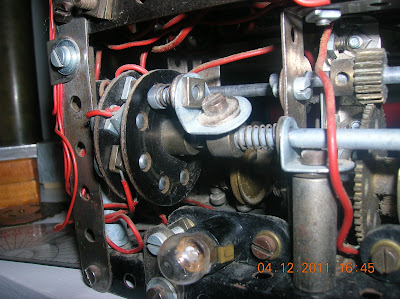The above is a picture of a contraption I built in 1980 in order to amuse myself and at the same time make use of my old redundant Meccano set, a set that included electrical parts such as solenoids. I decided to build something that would generate a disordered binary sequence. More views of the machine, including the output results, can be seen on my facebook album here.
So how does it work? The lower story of the machine consists of an assembly of cogs and band drives which periodically operate various switches. These switches interact electrically to produce a complex combined sequence of 1s and 0s. This sequence is stored in 8 bit chunks in the one byte solenoid memory occupying the upper story. A long sequence of 1s and 0s is therefore generated byte by byte; these bytes have to be marked up one at a time by hand on graph paper in order to build up a long sequence.
Yes, it’s nineteenth century technology, but it worked and moreover there is a moral in the tale.
If we represent the nth switch in the machine by the binary variable “Sn” and imagine that this variable switches between 1 and 0 with a particular periodicity, then the whole machine carries out the following logical operation:
(S1 + S2 + S3) . S4
Where “+” designates an “OR” operation and “.” designates an “AND” operation. For example, if switches 1 & 2 are “on”, switch 3 is “off” and switch 4 is “on” we get:
(1 + 1 + 0) .1 = 1
One way of thinking about this operation is to think of the combined result of S1, S2, and S3 to effectively select or “gate” the result of S4; that is, if (S1 + S2 + S3) generates a 1 then it allows through the binary pulses from S4.
If S1, S2 , S3 and S4 all have different switching periods then the logical expression above results in a quite complex (i.e. disordered) sequence in itself, especially if the periodicities of the switches are expressed in real numbers with lots of decimal places. These inherent real number constants have the effect of helping to generate chaotic sequences, although under these circumstances alone the sequences generated would nevertheless still display a measure of periodicity and therefore would be far from maximum disorder. However, the secret of the machine’s ability to disrupt periodicity and generate high disorder doesn’t just depend on the use of “real numbers” but in fact resides in three features:
1) "Analogue" band drives were employed and their non integral ratios produced real number periodicities; this entails the likelihood that the differing periodicities of S1, S2, S3 are not fully resolvable; that is in absolute terms the sequenced product of these three switches is a-periodic.
2) The other important feature of analogue band drives is that they have inevitable accuracy tolerances - unlike "digital" cogs which only produce exact integral ratios.
3) Compared to the other switches Switch 4 is made to switch on and off rapidly.
The result of these features means that the gating switches S1, S2, S3 force a sampling of S4 that is both chaotic and inaccurate. The inherent inaccuracy in the periods of the gating switches is of comparable size to the distance between the pulses delivered by the rapid switching of S4, giving rise to a probabilitistic hit or miss situation. The result; a very non-periodic disordered sequence. The “disordered” results can be seen in my facebook album.
Moral of the Tale.
The way disorder is generated in the above model reminds me very much of an idea mooted by Michael Frayn in his book “The Human Touch”. He suggests that quantum uncertainty is a result of the muddled and chaotic macroscopic world attempting to sample the precise periodicities of the microscopic world. In my model the macroscopic world is represented by the logical operation (S1 + S2 + S3) which is chaotic and inaccurate. The microscopic world is represented by the high frequency pulsing of S4 with its implied small “wavenumber”.
Frayn’s idea is a very neat idea and it is reminiscent of the quantum decoherence interpretation of the random jumps of the state vector, which as I have said here, is also a very neat idea. I must admit I’m very tempted by both ideas and they shouldn’t be discarded lightly. But, and here’s the inevitable “But"; as Roger Penrose points out decoherence does not easily explain the jumps of the state vector entailed by null results, (if indeed the state vector does jump under these circumstances) Secondly – and this is my own idea – the quantum wave calculus looks too much like an imaginary number version of probability calculus for us to discard the notion that those random jumps are actually absolute and not just a product of deterministic chaos. No wonder, then, that I gave my high frequency switch its own uncertainty; a static commutator with an electric current picked up by a rotating flailing sprung head. (See below)
High frequency switching is achieved by a static commutator and a rotating sprung pick up head.


No comments:
Post a Comment